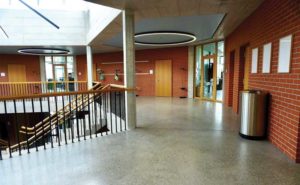How to fix concrete flooring challenges
by arslan_ahmed | June 2, 2023 4:00 pm
 [1]
[1]By Emily Newton
Concrete floors are popular choices as they are extremely durable and long-lasting if installed, cured, and finished properly. However, issues can arise during or after installation, and construction professionals must know how to diagnose and fix these concrete flooring challenges.
This article outlines some crucial steps to take when addressing challenges in slab-on-grade concrete floors, including those with polished or broom finishes. Although most relate to concrete floors installed indoors—in residential and commercial buildings—some tips also apply to those installed outdoors.
Determining the issues and causes
A good start in the troubleshooting process is to ask the clients when the issues started and if any activities caused them to worsen over time. Sometimes, environmental factors can exacerbate problems, for example, products for cleaning and deicing can harm the concrete, as can frequent traffic from heavy vehicles such as forklifts. If the concrete flooring is in a protected area, such as a garage, be aware of how people can track products such as deicing salts onto it by walking.
Clients may also need help because they noticed specific areas where the concrete floor has started to bulge. This issue generally occurs because of soil upheaval following heavy rainstorms—water builds under the concrete and pushes it up. Problems can also occur if the floor is exposed to freezing temperatures soon after installation.
Cracks are other common concrete flooring challenges. They could occur after a sudden impact, for example, if a heavy object is dropped onto the floor. In this case, the client can confirm exactly when and why the crack happened. However, it becomes more complicated if the cracks appear because of installation mistakes. For example, the installer may use too much water in the mix or select the wrong strength of concrete to pour.
Concrete slab design can include reinforcement to compensate for shrinkage, decreasing the possibility of cracking.1 Most cracks arise due to issues associated with how well the floor cured. Although the first few days are critical, concrete does not reach its full strength until at least 56 days after installation.
 [2]
[2]It is not always easy to pinpoint the root causes of problems with concrete flooring, but construction professionals should still do their best to determine what went wrong, because it can minimize the chances of repeat problems in the future.
Fixing concrete flooring challenges
Some construction professionals engage with clients who assumingly have relatively minor concrete floor issues—those customers may even wonder if the issues are necessary to address at all. This situation could also occur if a client believes the problem is merely a cosmetic one.
However, it is up to the professional providing construction services and advice to help clients gain broader perspectives and tell them the problem could get worse if they do not act quickly.
Consider a concrete-related moisture problem, for example. Concrete still contains moisture once it has fully cured.2 People can measure the relative humidity (RH) or the rate the moisture vapour moves through the concrete surface to determine if the material is too damp. Manufacturer guidance typically details which test methods to use and the acceptable moisture vapour transmission limits.
Concrete is relatively impervious to water and is often chosen for pipes and tanks. However, water vapour can become problematic, especially without an effective barrier. Although the ground is a moisture source, so is the concrete itself.3
Various complications can result if tests indicate the client has a concrete moisture problem and they decide to wait to fix it. The substrate can eventually deteriorate, or cracks can start to appear in the floor coating. The concrete surface can also become uneven, creating safety hazards in heavily used areas of a building. Some consequences are harder to see, including mould or pathogen growth beneath the floor’s surface.
The main point to get across to any client in this position is, it is better to act promptly instead of hoping the problem will not worsen. Even if the situation seems stable to the client, it could be an incorrect assumption as not all complications are immediately visible.
Discuss replacements and repairs
Once the specific problem and its scope is determined, it is important to discuss whether the best approach is to replace or repair the affected area. Replacements can be more expensive, but the overall cost may be worth it if the issue is extensive or if the client wants to make more-extensive improvements to the area.
For example, research indicates more than one-third of office-based employees do not get enough light in their workspaces.4 However, replacing faulty material with polished concrete can make a space look brighter and more inviting.
 [3]
[3]Repairs can solve many concrete flooring challenges, particularly if clients notice something amiss and contact professionals quickly. For example, some cracks appear with one side noticeably higher than the other. Uneven settling beneath the concrete’s base layer may cause this problem.5 However, injecting slurry or foam under the slab can sometimes remedy the problem.
If the concrete flooring challenges are too extensive to warrant successful repairs, a replacement will likely get the desired outcome. Discussion should take place regarding all the necessary particulars of that route, including what happens to the removed material.
People are more commonly using recycled materials in their homes.6 These options range from upcycled wood to shingles made from rubber. They may also decorate with recycled concrete pieces, particularly in smaller landscaping projects that add character to their properties.
Clarify needs and expectations
Once the concrete flooring challenges are identified, it is time to talk about the specifics. For example, what is the budget, and can there be financing options to make the costs more manageable? What steps can be taken to solve the issue, and what is the project’s overall time frame?
One common way to fix moisture issues is by placing a vapour retarder between the ground and concrete slab, particularly indoors. Although 6-mil poly was the standard choice for many years, it is now common to put a 10-mil barrier under parking-level slabs and increase that to 15- or 20-mils for habitable spaces. In addition, installers often recommend a fully waterproof membrane when water is under the slab. However, if someone still sees evidence of moisture after the fix, it does not necessarily mean the retarder failed. Humid conditions can also cause wetness on concrete flooring when warm air condenses into colder surfaces.
Clients will appreciate knowing how long it will take to get the concrete floors fixed, especially if the affected area plays a significant role in how they run their business. What amount of time must pass for the floor to cure properly and reduce the chances of complications later?
 [4]
[4]Bring up matters that may require the clients to change how they maintain or use the concrete floors. Do they need to use different cleaning products or stop parking vehicle, such as semitrucks, on the concrete for long periods? The more the client knows before the repair or replacement occurs, the better position they will be in to help the restored floor last longer.
Taking a thorough approach
Whether professionals need to tackle challenges that occurred soon after installation or years later, they should always do so with a careful approach which investigates the root causes and how to control them before the slab is poured. Once engineers evaluate site preparation, soil compaction and bearing strength, they can assess slab thickness and reinforcement measures. Control joints can also mitigate temperature-related cracking. Building use is one of the many other factors considered during this phase.
Maintaining quality control (QC) might mean hiring those with enough experience to lay the flooring and requiring them to complete ongoing training. It could also entail being more specific in conversations with clients about which aspects can make concrete floors fail after installation.
Keep in mind, the process used for fixing current concrete flooring challenges and mitigating future ones can directly impact a company or professional’s reputation—which is why it is best to cover all the bases and help the clients know what to expect.
Notes
1 Read more about best practices for installing concrete floors, www.nfca.ca/free-resources/ concretespecification/.
2 See moisture issues in concrete floors, www.buildings.com/sealants-coatings/article/10185704/signs-a-concrete-floor-has-moisture-issues.
3 Read more about vapour barriers for concrete floors, www.concrete.org/publications/international concreteabstractsportal.aspx?m=details&i=51735989.
4 For more information, read the benefits of polished concrete floors, www.dcpu1.com/blog/benefits-of-polished -concrete-floors/.
5 Learn how to repair cracks in concrete floors, www.thespruce.com/how-to-repair-concrete-floors-1398172.
6 See more features of recycled homes, revolutionized.com/interesting-features-of-recycled-houses-robots-you-probably-didnt-know-about/.
 [5]Author
[5]Author
Emily Newton is the editor-in-chief of Revolutionize Magazine. She has more than six years of experience writing industrial topics for the construction, manufacturing, and supply chain industries.
- [Image]: https://www.constructioncanada.net/wp-content/uploads/2023/05/OPENER.jpg
- [Image]: https://www.constructioncanada.net/wp-content/uploads/2023/05/maksym-tymchyk-XIemXZvH_Og-unsplash.jpg
- [Image]: https://www.constructioncanada.net/wp-content/uploads/2023/05/ricardo-gomez-angel-7Fo2o7XDQW0-unsplash.jpg
- [Image]: https://www.constructioncanada.net/wp-content/uploads/2023/05/azzedine-rouichi-KDM09YR4_bY-unsplash.jpg
- [Image]: https://www.constructioncanada.net/wp-content/uploads/2023/05/Newton_Headshot_F.jpg
Source URL: https://www.constructioncanada.net/how-to-fix-concrete-flooring-challenges/